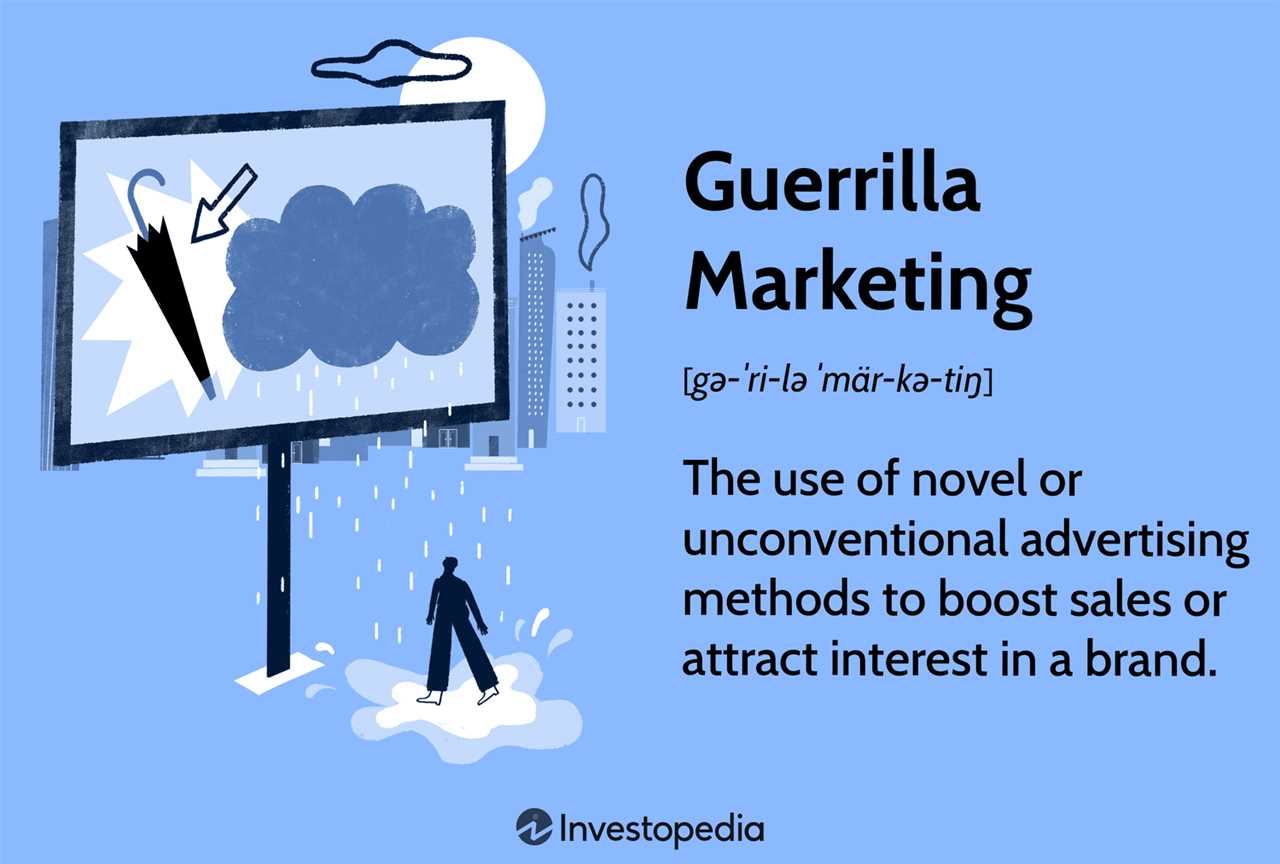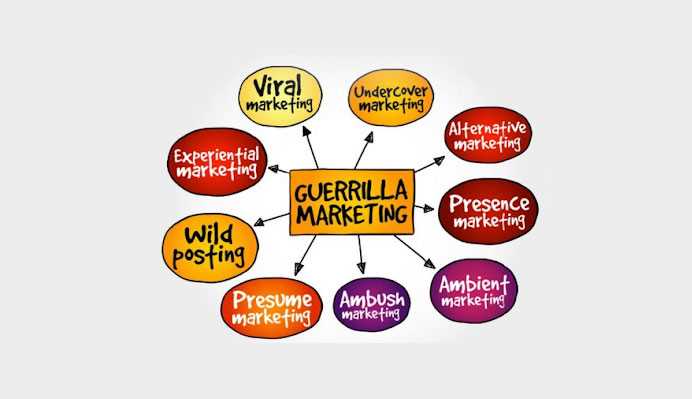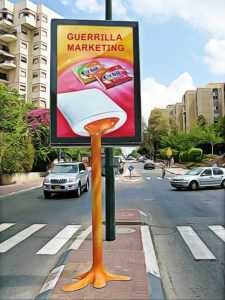What is Guerrilla Marketing?
Guerrilla marketing is a marketing strategy that focuses on unconventional and low-cost tactics to promote a product or service. It is a creative approach that aims to capture the attention of the target audience in unexpected ways, often using unconventional locations or methods. The goal of guerrilla marketing is to create a memorable and engaging experience that generates buzz and word-of-mouth promotion.
Guerrilla marketing is all about thinking outside the box and finding unique ways to reach consumers. It is a strategy that can be used by businesses of all sizes, from small startups to large corporations. The main benefit of guerrilla marketing is its ability to create a big impact with a small budget. By using unconventional tactics, businesses can generate a lot of attention and buzz without spending a fortune on traditional advertising methods.
Another benefit of guerrilla marketing is its ability to create a personal and interactive experience for consumers. By engaging with the target audience in unexpected ways, businesses can create a memorable and emotional connection that traditional advertising methods often lack. This can lead to increased brand loyalty and customer engagement.
Examples of Guerrilla Marketing
There are many creative and successful examples of guerrilla marketing campaigns. One example is the “Fearless Girl” statue that was placed in front of the Wall Street bull in New York City. This guerrilla marketing tactic was used by an investment firm to promote gender diversity in the workplace and received widespread media coverage.
Another example is the “Red Bull Stratos” campaign, where Felix Baumgartner jumped from the edge of space. This extreme stunt generated a lot of attention and buzz for Red Bull, resulting in increased brand awareness and sales.
These examples demonstrate the power of guerrilla marketing to create a memorable and impactful experience for consumers.
Guerrilla marketing is a unique and unconventional marketing strategy that aims to create a big impact with minimal resources. It involves using creative and unexpected tactics to grab the attention of the target audience and generate buzz around a product, service, or brand.
One of the key benefits of guerrilla marketing is its ability to create a memorable and lasting impression. By thinking outside the box and implementing unconventional tactics, companies can differentiate themselves from their competitors and leave a lasting impression on their target audience.
Another benefit of guerrilla marketing is its cost-effectiveness. Traditional marketing methods often require a significant budget to reach a wide audience. However, guerrilla marketing relies on creativity and innovation rather than a large budget. This makes it a great option for small businesses or startups with limited resources.
Furthermore, guerrilla marketing can generate a lot of buzz and word-of-mouth publicity. When executed successfully, these unconventional campaigns can create a buzz on social media, generate media coverage, and spark conversations among consumers. This organic publicity can significantly increase brand awareness and reach a wider audience.
Examples of Guerrilla Marketing
Guerrilla marketing is all about thinking outside the box and coming up with creative and unconventional ways to promote a product or service. Here are some examples of successful guerrilla marketing campaigns that have made a big impact:
- The Ice Bucket Challenge: This viral campaign raised awareness and funds for ALS research by challenging people to dump a bucket of ice water on their heads and donate to the cause. It spread like wildfire on social media, with celebrities and everyday people participating and sharing their videos.
- The Red Bull Stratos Jump: Red Bull sponsored Felix Baumgartner’s record-breaking freefall from the edge of space. The event was streamed live on the internet and garnered millions of views. It showcased Red Bull’s brand message of pushing boundaries and taking risks.
- The Dove Real Beauty Sketches: Dove created a video campaign that showed women describing themselves to a forensic sketch artist. Then, strangers described the same women to the artist. The resulting sketches showed that women often see themselves as less beautiful than others perceive them. The campaign went viral and sparked conversations about beauty standards.
- The Burger King Whopper Detour: Burger King launched a campaign that encouraged customers to download their app and order a Whopper. The catch was that customers had to be within 600 feet of a McDonald’s to unlock the deal. This cheeky campaign not only increased app downloads but also generated buzz and media coverage.
- The ALS “Tweet to Beat” Campaign: ALS launched a Twitter campaign where users could tweet #BeatALS to trigger a $1 donation from the organization. The campaign went viral, with celebrities and influencers spreading the word and encouraging their followers to participate. It raised millions of dollars for ALS research.
These examples demonstrate the power of guerrilla marketing to capture attention, engage audiences, and generate buzz. By thinking creatively and taking risks, brands can create memorable campaigns that leave a lasting impact on consumers.
Innovative Campaigns That Made an Impact
1. The Ice Bucket Challenge
The Ice Bucket Challenge was a viral campaign that took social media by storm in 2014. It involved people pouring a bucket of ice water over their heads and challenging others to do the same or donate to ALS research. The campaign not only raised awareness about ALS but also raised millions of dollars for the cause. It was a perfect example of how a simple idea can spread like wildfire and have a real impact.
2. The Red Bull Stratos Jump

In 2012, Red Bull sponsored Felix Baumgartner’s record-breaking freefall from the edge of space. The event was broadcast live on television and the internet, capturing the attention of millions of people around the world. It was a daring and exciting stunt that showcased Red Bull’s brand values of adventure and extreme sports. The campaign generated massive media coverage and solidified Red Bull’s position as an innovative and daring brand.
3. The Dove Real Beauty Campaign
The Dove Real Beauty Campaign is a long-running guerrilla marketing campaign that challenges traditional beauty standards. The campaign features real women of all shapes, sizes, and ages, promoting the message that beauty comes in all forms. It has included billboards, print ads, and videos that have gone viral. The campaign has been praised for its inclusivity and positive message, and it has helped to redefine beauty standards in the advertising industry.
4. The Nike+ Run Club
The Nike+ Run Club is an innovative guerrilla marketing campaign that combines technology and fitness. Nike created an app that tracks users’ running progress and provides personalized coaching and motivation. The campaign also includes regular running events and challenges, creating a sense of community among Nike+ users. The campaign has been highly successful in promoting Nike’s brand and encouraging people to lead an active lifestyle.
These are just a few examples of innovative guerrilla marketing campaigns that have made a significant impact. They demonstrate the power of creativity, storytelling, and engaging experiences in capturing people’s attention and creating a lasting impression. By thinking outside the box and taking risks, brands can create campaigns that resonate with their target audience and generate buzz.
The History of Guerrilla Marketing
Guerrilla marketing, a creative and unconventional approach to marketing, has a rich history that dates back several decades. The term “guerrilla marketing” was coined by Jay Conrad Levinson in his book “Guerrilla Advertising” in 1984. However, the concept of guerrilla marketing can be traced back even further.
The roots of guerrilla marketing can be found in the 1960s and 1970s, during a time when traditional advertising methods were becoming less effective. As consumers became more skeptical of traditional advertising messages, marketers had to find new ways to capture their attention.
One of the earliest examples of guerrilla marketing can be seen in the work of Andy Warhol, an American artist known for his pop art. Warhol’s approach to marketing was unconventional and disruptive. He used bold and eye-catching visuals to promote his artwork, often blurring the lines between art and advertising.
In the 1980s, guerrilla marketing gained popularity as a result of the changing media landscape. With the rise of cable television and the decline of traditional print media, marketers had to find new ways to reach their target audience. Guerrilla marketing offered a cost-effective and creative solution.
During this time, companies like Nike and Apple embraced guerrilla marketing tactics to promote their products. Nike, for example, launched the “Just Do It” campaign, which featured athletes in unexpected and unconventional settings. This campaign not only captured the attention of consumers but also positioned Nike as a brand that celebrated individuality and pushing boundaries.
In the 1990s and early 2000s, guerrilla marketing continued to evolve with the advent of the internet and social media. Companies like Red Bull and Blendtec used viral videos and social media stunts to generate buzz and engage with their audience.
Today, guerrilla marketing continues to be a powerful and effective strategy for brands looking to make a memorable impact. With the rise of technology and the increasing clutter of traditional advertising, guerrilla marketing offers a way for brands to stand out and connect with consumers on a deeper level.
Origins and Evolution of the Strategy
Guerrilla marketing has its roots in unconventional warfare tactics, where small, agile forces would use surprise and unconventional methods to overcome larger, more powerful opponents. The term “guerrilla” itself comes from the Spanish word for “little war,” and it was first used to describe the tactics employed by Spanish guerrillas during the Peninsular War in the early 19th century.
However, the concept of guerrilla marketing as we know it today didn’t emerge until the 1980s. It was popularized by Jay Conrad Levinson, who wrote the book “Guerrilla Marketing” in 1984. In his book, Levinson outlined a new approach to marketing that focused on creativity, innovation, and low-cost strategies.
Since then, guerrilla marketing has evolved and adapted to the changing marketing landscape. With the rise of the internet and social media, guerrilla marketing has become even more powerful and effective. It allows businesses to reach a wider audience, engage with customers in a more personal way, and create memorable experiences that leave a lasting impression.
Today, guerrilla marketing is not limited to small businesses or startups. Many large corporations and well-known brands have embraced the strategy and incorporated it into their marketing campaigns. It has become a mainstream marketing technique that is used by businesses of all sizes and industries.
The evolution of guerrilla marketing has also led to the emergence of new tactics and techniques. From viral videos and interactive installations to street art and flash mobs, there are countless ways to create a guerrilla marketing campaign that captures attention and generates buzz.
Overall, the origins and evolution of guerrilla marketing demonstrate its effectiveness and staying power as a marketing strategy. It continues to be a valuable tool for businesses looking to stand out in a crowded marketplace and make a memorable impact on their target audience.
How to Implement Guerrilla Marketing
Implementing guerrilla marketing tactics can be a creative and effective way to promote your brand or business. Here are some steps to help you get started:
1. Identify Your Target Audience
2. Set Clear Objectives
Define what you want to achieve with your guerrilla marketing campaign. Whether it’s increasing brand awareness, driving sales, or generating buzz, setting clear objectives will help you measure the success of your efforts.
3. Be Creative and Unique

Guerrilla marketing is all about thinking outside the box and coming up with unique and creative ideas. Find ways to grab attention and stand out from the competition. Use unconventional tactics and unexpected locations to make a lasting impression.
4. Utilize Social Media
Social media platforms are powerful tools for guerrilla marketing. Leverage platforms like Facebook, Instagram, and Twitter to amplify your message and reach a wider audience. Create shareable content that encourages people to engage and spread the word.
5. Collaborate with Influencers
Partnering with influencers in your industry can help amplify your guerrilla marketing efforts. Identify influencers who align with your brand and have a strong following. Collaborate with them to create content or promote your campaign to their audience.
6. Measure and Analyze Results

Regularly monitor and analyze the results of your guerrilla marketing campaign. Use tools like Google Analytics to track website traffic, social media metrics, and other key performance indicators. This data will help you understand what’s working and what needs improvement.
7. Stay Consistent and Evolve

Consistency is key in guerrilla marketing. Keep your messaging and branding consistent across all channels and campaigns. As you gain insights and feedback, be willing to adapt and evolve your tactics to stay relevant and continue capturing attention.
By following these steps and embracing the spirit of guerrilla marketing, you can create impactful and memorable campaigns that resonate with your target audience and help your brand stand out in a crowded marketplace.

Emily Bibb simplifies finance through bestselling books and articles, bridging complex concepts for everyday understanding. Engaging audiences via social media, she shares insights for financial success. Active in seminars and philanthropy, Bibb aims to create a more financially informed society, driven by her passion for empowering others.
